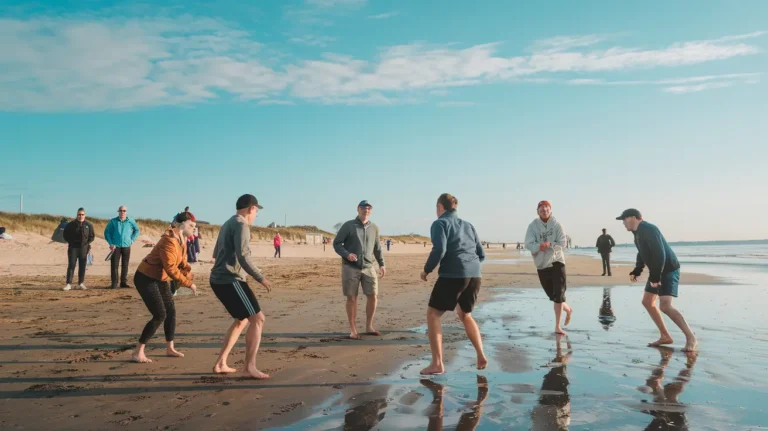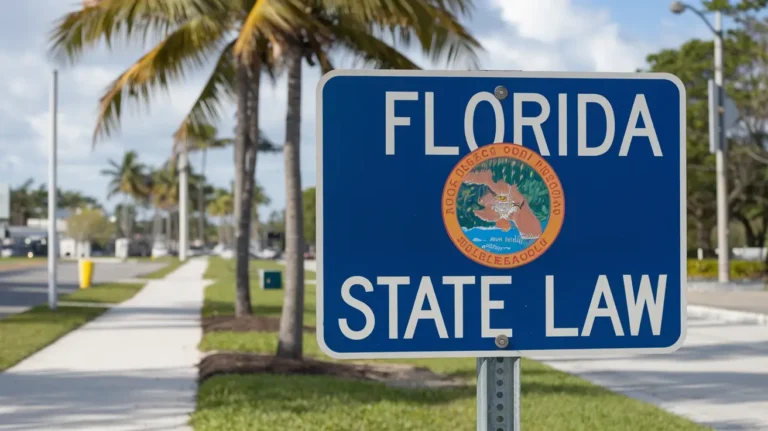How to Travel Europe for 2 Weeks? 3 Exciting Destinations and Essential Tips for an Amazing 14-Day Trip
How to Travel Europe for 2 Weeks? Exploring Europe in two weeks is a thrilling experience, offering a taste of the continent’s rich history, diverse cultures, and vibrant cities. With so many iconic sites and destinations, planning a well-rounded trip can be challenging. This guide offers a structured two-week plan, complete with essential travel tips, budgeting advice, and popular routes to help you maximize your European adventure.

Table of Contents
- Deciding on a European Travel Route
- Also Read: Florida State Law on Compensation for Travel Time? 4 Powerful Types
- Sample 2-Week Plan for Europe
- Tips for Traveling Around Europe Efficiently
- Budgeting for a 2-Week Trip to Europe
- Essential Travel Tips for a European Adventure
- Packing Light and Smart
- Safety Tips for Tourists
- Is It Worth Going to Europe for 2 Weeks?
- How Many European Countries Can I Visit in 2 Weeks?
- What Is a Good Budget for a 2-Week Trip to Europe?
- How Much Does a 15-Day Trip to Europe Cost?
- 2-Week Europe Plan by Train
- How to Travel Europe for 2 Weeks by Train
- Europe Plan for 2 Weeks on a Budget
- Best Europe Trip Plan for a 2-Week Adventure
- 21 Days in Europe Plan
- 15 Days Europe Tour Plan
- How to Plan an Epic 2-Week Europe Trip
- How to Plan an Epic 2-Week Summer Europe Plan
- Conclusion: How to Travel Europe for 2 Weeks?
- FAQs About Traveling Europe for 2 Weeks
- What’s the best time of year to travel to Europe?
- Is it possible to visit multiple countries in two weeks?
- How much should I budget for a 2-week trip?
- What travel documents do you need?
- Should I book accommodations in advance?
- Can I use my phone and credit cards easily in Europe?
- How many countries can I visit in two weeks in Europe?
- Is train travel the best way to explore Europe?
- How much should I budget for a two-week Europe trip?
- What’s the best time to travel to Europe?
- Is it worth going to Europe for only two weeks?
Deciding on a European Travel Route
Europe is home to countless historic sites, scenic landscapes, and cultural treasures. Given limited time, it’s wise to focus on specific regions to minimize travel time and maximize sightseeing. Here are some popular regional travel routes to consider:
Western Europe Highlights
Western Europe is famous for iconic sites, artistic heritage, and renowned landmarks. France, Italy, and Spain are ideal for first-time travelers, featuring destinations like:
- Paris, France: The Eiffel Tower, Louvre Museum, Notre-Dame Cathedral, and charming neighborhoods like Montmartre.
- Rome, Italy: Home to the Colosseum, Vatican City, and authentic Italian cuisine.
- Barcelona, Spain: Admire the unique architecture of Antoni Gaudí, especially the Sagrada Família and Park Güell.

Central Europe Charmers
For those interested in rich history and beautiful landscapes, Central Europe offers a mix of classic charm and modernity. Key spots include:
- Berlin, Germany: Known for its history, museums, and vibrant art scene.
- Vienna, Austria: A city of classical music, grand palaces, and cozy coffeehouses.
- Zurich, Switzerland: Perfect for scenic landscapes and outdoor activities.
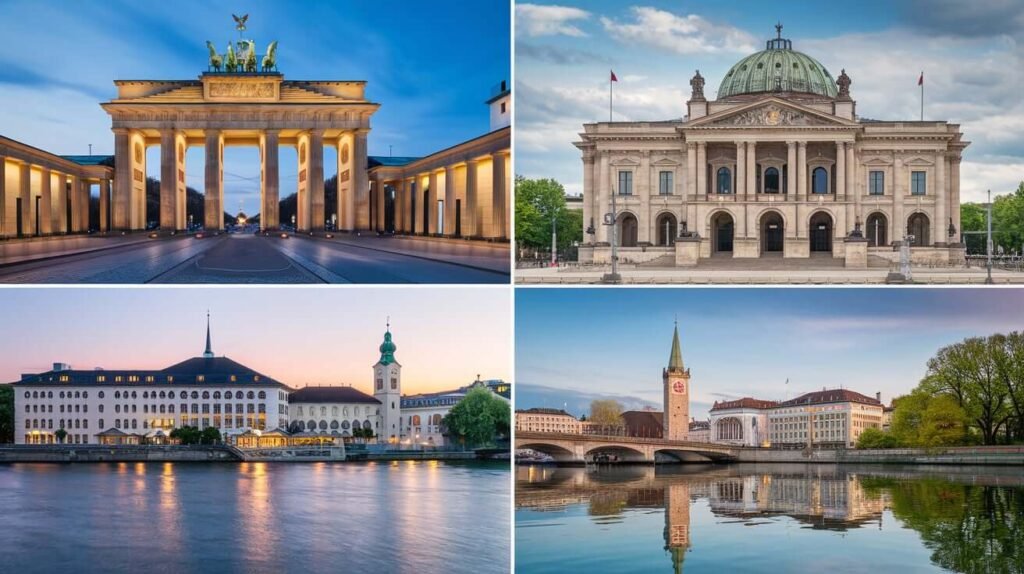
Eastern Europe Gems
Eastern Europe provides an affordable travel experience with picturesque cities and less-crowded attractions. Top picks are:
- Krakow, Poland: Discover medieval architecture and historical sites, like Wawel Castle.
- Prague, Czech Republic: Famous for its Gothic charm and the bustling Old Town Square.
- Budapest, Hungary: Enjoy thermal baths, the historic Buda Castle, and the scenic Danube River.
Also Read: Florida State Law on Compensation for Travel Time? 4 Powerful Types

Sample 2-Week Plan for Europe
Here’s a detailed two-week plan to help you explore Europe’s top cities, including travel suggestions and highlights for each location.
Days 1-3: Paris, France
Start your trip in Paris, the City of Light. Key sites to visit include:
- Eiffel Tower: Start with a visit to this iconic landmark, followed by a stroll along the Seine River.
- Louvre Museum: Home to the Mona Lisa and a vast art collection, it’s worth allocating at least half a day here.
- Montmartre: Visit the Sacré-Cœur Basilica and enjoy the artistic atmosphere of this charming area.

Travel Tip: Buy museum tickets online to skip the lines.
Days 4-6: Rome and Florence, Italy
Take a short flight or train to Italy and explore Rome and Florence.
- Rome: Explore the Colosseum, Roman Forum, and Vatican City, including the Sistine Chapel.
- Florence: Known as the birthplace of the Renaissance, it offers must-sees like the Uffizi Gallery and Florence Cathedral.

Travel Tip: Use guided tours to maximize time and skip queues at popular attractions.
Days 7-9: Vienna and Prague
Head east to Central Europe, starting with Vienna.
- Vienna: Visit Schönbrunn Palace, the Vienna State Opera, and St. Stephen’s Cathedral.
- Prague: Walk the Charles Bridge, explore Prague Castle, and spend time in the Old Town Square.

Travel Tip: Central Europe offers excellent public transportation, so consider multi-city train tickets.
Days 10-12: Berlin and Amsterdam
Continue to Berlin, Germany, and Amsterdam, Netherlands.
- Berlin: Visit the Berlin Wall Memorial, Brandenburg Gate, and Museum Island.
- Amsterdam: Explore the Van Gogh Museum, Anne Frank House, and take a canal cruise.
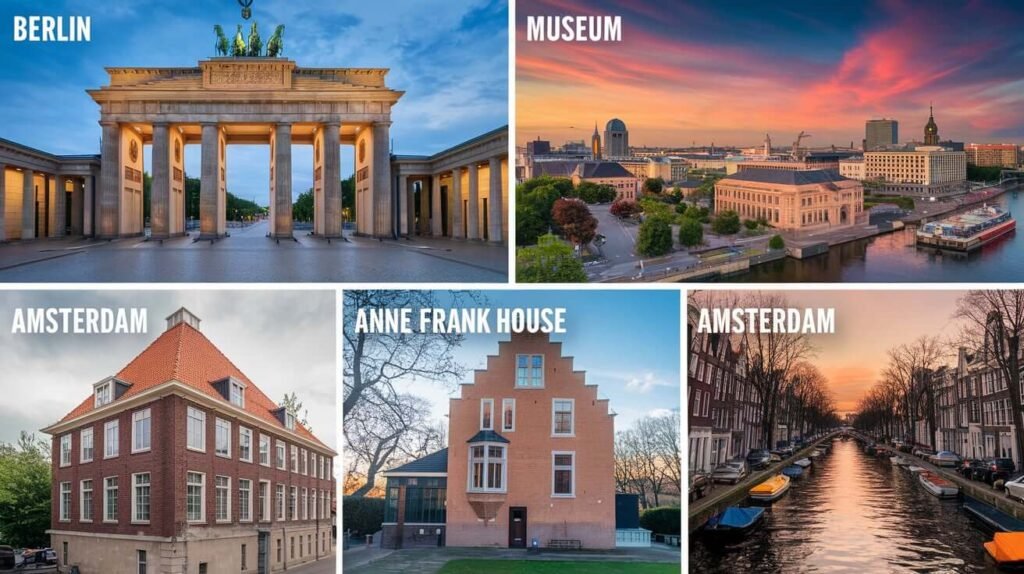
Travel Tip: Purchase an Amsterdam City Card for entry to major attractions and free public transport.
Days 13-14: Ending in London, UK
Conclude your journey in London.
- London: Visit Buckingham Palace, Big Ben, and the British Museum. Consider a Thames River cruise for unique city views.
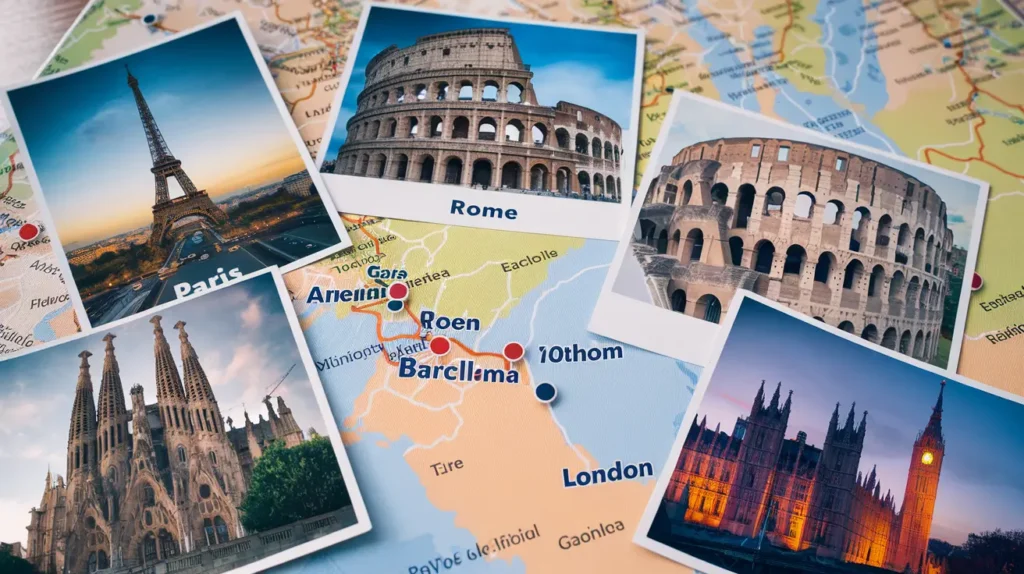
Travel Tip: Public transportation, particularly the London Underground, is the most efficient way to get around.
Tips for Traveling Around Europe Efficiently
Rail Pass vs. Budget Airlines
- Rail Pass: Ideal for shorter distances, allowing flexibility to hop between cities. Eurail and Interrail passes are convenient for unlimited train travel across Europe.
- Budget Airlines: Faster for long distances, often at reasonable prices. Popular airlines include Ryanair, easyJet, and Wizz Air.

Public Transport and Walking
Europe’s cities are known for efficient public transportation systems, and many are pedestrian-friendly. Walking around is also a great way to immerse yourself in local culture.
Budgeting for a 2-Week Trip to Europe
Budgeting is key to making the most of your European adventure. Here are some tips to keep costs manageable:
Affordable Accommodation
Consider hostels, budget hotels, and Airbnb for affordable stays. Many hostels in Europe offer private rooms for a more comfortable yet economical option.
Food and Dining
Eating at local markets, bakeries, and casual restaurants will save money while allowing you to try authentic cuisine. Many cities also offer street food options that are budget-friendly and delicious.
Essential Travel Tips for a European Adventure

Packing Light and Smart
Pack versatile clothing for different climates, especially if you’re traveling across multiple countries. A good rule of thumb is to bring essentials only and consider laundry services for longer trips.
Safety Tips for Tourists
Europe is generally safe for travelers, but always remain vigilant, especially in crowded areas. Keep an eye on personal belongings to avoid pickpocketing, particularly in busy cities.
Is It Worth Going to Europe for 2 Weeks?
Absolutely! A two-week trip is enough to experience several of Europe’s highlights, allowing you to explore multiple cities, savor the local culture, and visit famous landmarks. While you can’t see everything, a well-planned plan will give you a fantastic overview of European culture, history, and lifestyle.
How Many European Countries Can I Visit in 2 Weeks?
The ideal number of countries to visit depends on your travel style.
Balancing Travel and Leisure
For a balanced and enjoyable experience, aim to visit about two to four countries. This approach will allow you to soak in the local atmosphere without feeling rushed or exhausted.
Sample Country Combinations
Some popular multi-country routes include:
- France, Switzerland, and Italy
- Germany, Austria, and the Czech Republic
- Spain and Portugal
These combinations allow for smooth travel connections and give you a variety of experiences within a reasonable timeframe.
What Is a Good Budget for a 2-Week Trip to Europe?
Budgeting for a European trip depends on several factors, including travel preferences and destination choices. Here’s a breakdown to help estimate costs:
Accommodation
- Hostels or budget hotels: $40–$70 per night
- Mid-range hotels: $80–$150 per night
- Luxury hotels: $200+ per night

Food and Dining
- Budget: $20–$30 per day if you choose casual dining or self-cater.
- Moderate: $40–$70 per day for a mix of sit-down and casual meals.
- High-end: $80+ per day for fine dining.
Transportation
- Train and bus travel are usually affordable across Europe, and a Eurail Pass or other travel passes can help reduce costs if you’re planning to visit multiple cities.
Total Estimated Budget
For two weeks, plan on spending $3,000–$5,000 USD per person on average for a comfortable trip that includes accommodation, dining, transportation, and sightseeing.
How Much Does a 15-Day Trip to Europe Cost?
For a 15-day European adventure, here are estimated costs based on a typical budget:
- Flights: $500–$1,500, depending on season and origin.
- Accommodation: $1,200–$2,500 for two weeks, depending on hotel type.
- Food and Dining: $300–$1,000, depending on dining preferences.
- Transport and Sightseeing: $300–$800, depending on attractions and transport options.
In total, a 15-day trip to Europe typically costs between $3,500 and $6,000 USD per person.
2-Week Europe Plan by Train
Europe’s train system makes it easy to navigate multiple countries efficiently. Here’s how to plan a 2-week Europe plan by train:
- Days 1–3: Paris, France
- Explore the Eiffel Tower, Louvre Museum, and historic Montmartre.
- Days 4–5: Lucerne, Switzerland
- Enjoy the scenic Lake Lucerne, take a mountain excursion, and try Swiss chocolate.
- Days 6–8: Venice, Italy
- Wander through St. Mark’s Square, take a gondola ride, and explore hidden canals.
- Days 9–11: Florence, Italy
- See the Florence Cathedral, Uffizi Gallery, and nearby Tuscan countryside.
- Days 12–14: Rome, Italy
- Visit the Colosseum, Roman Forum, Vatican City, and enjoy authentic Italian cuisine.
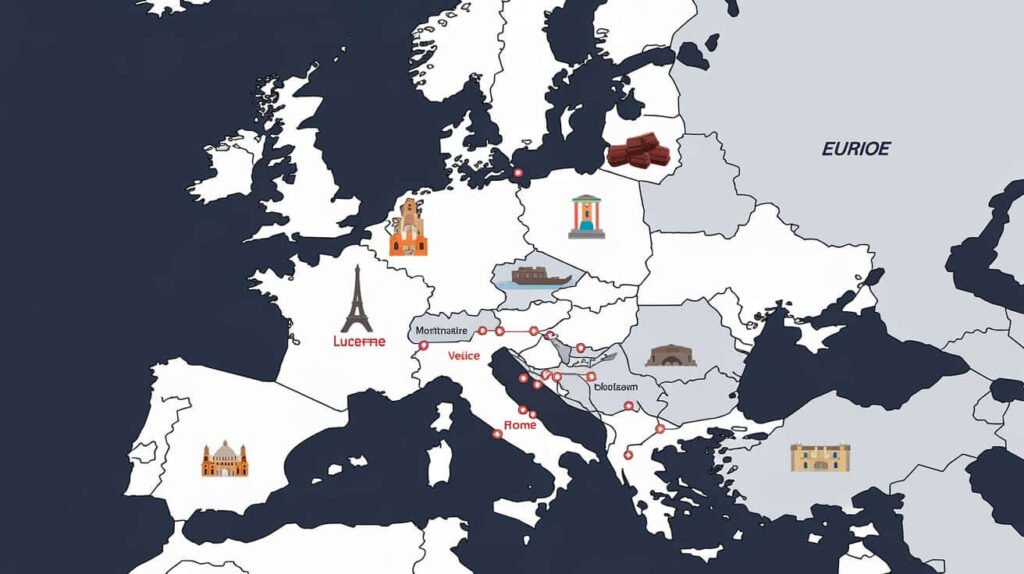
How to Travel Europe for 2 Weeks by Train
To make the most of train travel in Europe:
- Get a Eurail Pass: This pass allows flexible travel in many European countries, perfect for a multi-destination plan.
- Book High-Speed Routes in Advance: High-speed trains (such as France’s TGV or Spain’s AVE) save time, but reservations are recommended.
- Plan for Scenic Routes: Europe has some breathtaking train journeys, especially through the Alps, between cities like Lucerne and Milan.
Europe Plan for 2 Weeks on a Budget
To keep your budget manageable, try this more economical two-week plan:
- Days 1–4: Prague, Czech Republic – Affordable accommodation, beautiful city views, and budget-friendly dining options.
- Days 5–8: Budapest, Hungary – Stunning architecture, historic baths, and low-cost attractions.
- Days 9–11: Vienna, Austria – Walkable city with beautiful palaces and classical music history.
- Days 12–14: Berlin, Germany – Rich in history and culture, with many free museums and landmarks.
This plan focuses on Eastern and Central Europe, which are generally more affordable than Western Europe.
Best Europe Trip Plan for a 2-Week Adventure
For an unforgettable two-week European adventure, consider combining major highlights with some lesser-known gems:
- Days 1–3: London, UK – Big Ben, Buckingham Palace, and the Thames.
- Days 4–5: Amsterdam, Netherlands – Canals, Van Gogh Museum, and cycling.
- Days 6–8: Paris, France – Eiffel Tower, Seine River, and exquisite cafes.
- Days 9–11: Barcelona, Spain – Gothic Quarter, Sagrada Familia, and beach vibes.
- Days 12–14: Rome, Italy – Ancient landmarks, Vatican, and Italian food.
21 Days in Europe Plan
For travelers with three weeks, add more cities or day trips:
- Days 1–4: London and surrounding areas, including Windsor.
- Days 5–8: Amsterdam and Brussels.
- Days 9–12: Paris, including a day trip to Versailles.
- Days 13–15: Lucerne, Switzerland for alpine views.
- Days 16–18: Florence and Tuscany.
- Days 19–21: Rome and the Amalfi Coast.
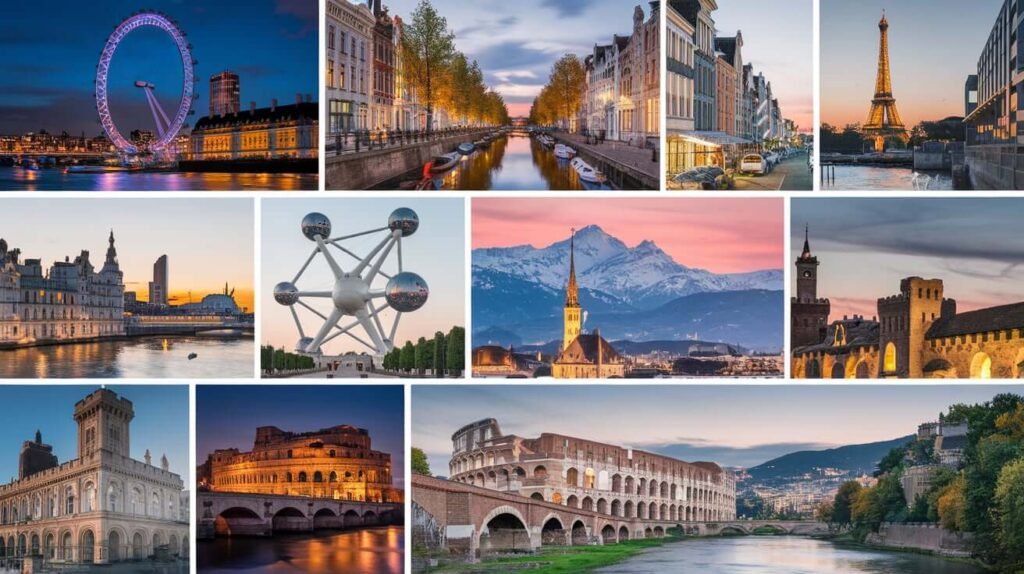
A 21-day plan allows more time for exploration and a slower pace.
15 Days Europe Tour Plan
For a 15-day Europe trip, follow this slightly expanded plan:
- Days 1–3: London.
- Days 4–5: Paris.
- Days 6–8: Munich and Bavaria.
- Days 9–11: Vienna.
- Days 12–15: Rome and the Vatican.
How to Plan an Epic 2-Week Europe Trip
- Choose Your Destinations: Pick 2-3 countries or 3-4 cities for a balanced plan.
- Book Flights and Accommodation Early: Save money and secure good locations by booking early.
- Map Out Transportation: Decide on train, bus, or plane routes, depending on distance and budget.
- Plan Your Activities: Research top sites and make necessary reservations.
- Leave Room for Flexibility: Include free time for spontaneous exploration!
How to Plan an Epic 2-Week Summer Europe Plan
For summer travel, consider including beach destinations:
- Days 1–3: Paris, with its parks and river cruises.
- Days 4–6: Nice, France for Mediterranean beaches.
- Days 7–9: Cinque Terre, Italy – picturesque villages and coastal hikes.
- Days 10–12: Florence – art and gelato.
- Days 13–14: Rome – historic sites and vibrant nightlife.
Conclusion: How to Travel Europe for 2 Weeks?
A two-week European journey is a whirlwind of culture, history, and adventure. From the art museums of Paris to the canals of Amsterdam, and the medieval castles in Prague, each city offers its own distinct charm. Careful planning, choosing the right travel route, and budgeting can transform your trip into a seamless, memorable experience.
Take the time to immerse yourself in each destination, savor local foods, and interact with locals to gain a genuine understanding of each place. Europe has a lifetime’s worth of sites to see, so enjoy your taste of it on this two-week journey, and let it inspire future adventures across this incredible continent.
FAQs About Traveling Europe for 2 Weeks
What’s the best time of year to travel to Europe?
Spring (April-June) and fall (September-October) offer pleasant weather, fewer crowds, and affordable prices.
Is it possible to visit multiple countries in two weeks?
Yes! A well-planned plan allows you to see multiple cities in different countries, especially with efficient transport options.
How much should I budget for a 2-week trip?
Costs vary, but $2,000–$3,500 is a reasonable budget for flights, accommodation, food, and activities.
What travel documents do you need?
Ensure you have a valid passport with at least six months before expiration. For most non-European travelers, a Schengen visa is required to visit many European countries. UK travel may require a separate visa or entry requirements based on your nationality.
Should I book accommodations in advance?
Yes, booking in advance is recommended, especially during peak travel seasons. This secures better prices and guarantees availability, especially in popular cities.
Can I use my phone and credit cards easily in Europe?
Most European cities offer good cellular networks, and major credit cards are widely accepted. However, carry some local currency (euros, pounds, etc.) for smaller shops, cafes, or rural areas that may only accept cash.
How many countries can I visit in two weeks in Europe?
Two to four countries is ideal for a balanced experience without feeling rushed.
Is train travel the best way to explore Europe?
Yes, trains are often convenient, especially with a Eurail Pass, offering scenic routes and easy city access.
How much should I budget for a two-week Europe trip?
A budget of $3,000–$5,000 USD per person is typical, covering flights, accommodations, food, and attractions.
What’s the best time to travel to Europe?
Late spring (May) or early fall (September) offers pleasant weather, fewer crowds, and often lower prices.
Is it worth going to Europe for only two weeks?
Yes, with good planning, a two-week trip is enough to enjoy Europe’s highlights and experience its diverse cultures.


